Welcome to the eighth instalment in our safety feature campaign series: Devitt Rider Safety with road safety journalist @djrwilliams.
We’re on a mission to create heightened awareness and debate around vital rider safety topics, initiatives and campaigns. Riders love to talk about all the latest safety and riding skills and here, at Devitt, we aim to be at the very forefront of that discussion.
Join the debate today on social media at #DevittRiderSafety
Any rider who’s been knocked off their bike – or had a close shave – knows only too well that other drivers never see you coming. It’s even given rise to an acronym: SMIDSY (Sorry Mate, I Didn’t See You).
One man became so obsessed with the phenomenon he made it his life’s work to unravel the mystery and – after years of digging – he discovered exactly what happens when a driver looks straight at you – then pulls out in front. Often at the very last second.
It’s not just carelessness or something blocking their view; it’s also caused by an evolutionary quirk in the way our brain interprets messages from our eyes.
The bad news? There’s no known cure. The good news? There are lots of actions you can take to minimise the risk, and we outline some of them here.
It all started for Kevin when, after completing a science degree, then working as a courier for 16 years, he trained to become a CBT instructor.
“New riders were encouraged to use hi-vis and day riding lights to stay safe,” says Kevin, “but my experience as a courier told me that lights and hi-vis made no difference. I felt that the best SMIDSY defence was to be on the lookout for it and be ready to take evasive action: not to rely on someone else seeing me in the first place.”
Kevin – a full-time advanced rider coach – spent years researching the problem, finally creating the Science of Being Seen (SOBS) which went on to become part of the fire services’ ‘Biker Down’ courses.
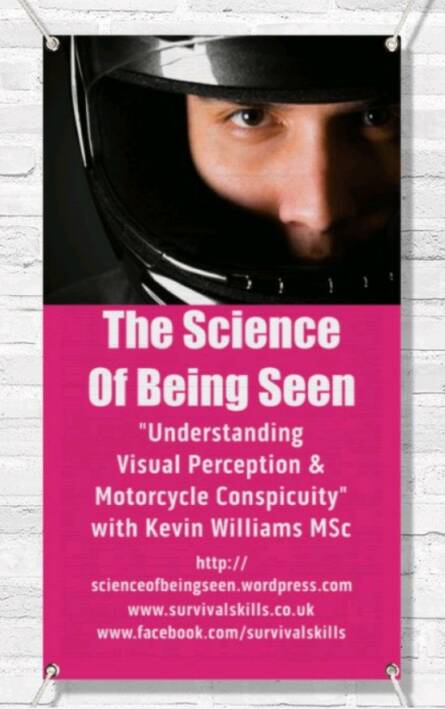
The more Kevin explored the science, however, the more perturbed he became. He knew the Department of Transport had tried to fix the problem too, with high-profile campaigns urging drivers to look out for bikes – especially at junctions – where most accidents occur.
“Unfortunately, while the Think Bike campaigns have limited effect, it doesn’t seem to last. Collisions at junctions are just as common as they ever were. Drivers basically still don’t see motorcycles,” says Kevin. In fact police data has shown that around 64 per cent of bike accidents occur at junctions.
Three kinds of accident
Kevin’s research led him to conclude that there are three fundamental scenarios in which motorists – including riders – often make fatal miscalculations.
The first accounts for one in five collisions and occurs when the rider simply isn’t where the driver can see them. It could be because the rider is filtering, or because something obscures the driver’s view.
The second group of collisions is the ‘looked but failed to see’ crashes (or ‘looked but forgot’) accounting for around one in three collisions.
The third group, accounting for roughly one in three collisions, occurs when the driver sees the bike but misjudges its speed and distance.
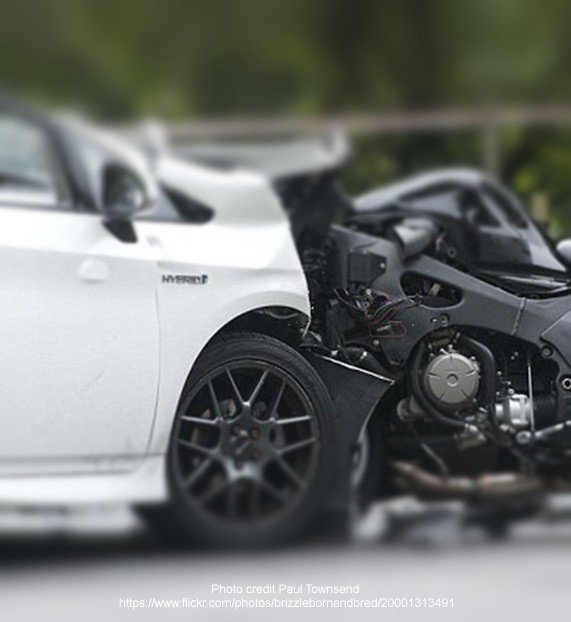
Every other accident scenario – including ‘distracted drivers’ and ‘drivers on their phones – accounts for just eight per cent of all collisions.
“Those three scenarios aren’t so much “driver didn’t look” as “driver looked but something went wrong’,” says Kevin. “I wanted to get to the bottom of why it goes wrong.”
Vision Blockers
“Sometimes the driver genuinely tries to see you but can’t because of an obstruction,” says Kevin. “It might be a pillar, or another car, or a pedestrian.”
So here’s the science. The first issue is anything that blocks the driver’s view. Often, it’s the driver’s own car, especially in newer models with thick pillars designed to protect the driver in a crash.
Ironically, they make it far harder to see other objects – especially small ones like bikes. Kevin says pillars have also become thicker to house airbags and audio systems.
There’s a neat way to prove this, says Kevin. Stand in front of your bike and hold out your hand at arm’s length – roughly the distance from your eyeballs to that thick pillar for a car driver.
Your palm is roughly the width of the pillar, so stand back and see how easy it is to hide your entire bike with just your hand.
Now see how close you can get to your bike before it begins to appear around your hand; probably very close indeed. “Imagine the bike riding towards you at speed and see how much time you have to react!” says Kevin.
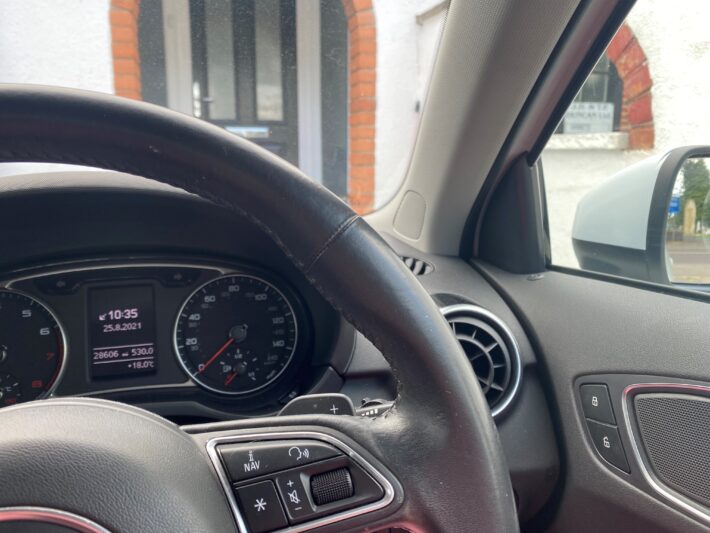
ACTION: Always look to open up lines of sight to see and be seen. If you can’t see the driver’s eyes, the driver can’t see you.
Pinpoint
There’s another problem and it’s all to do with the narrow zone of clear visual
focus in the human eye. “You think you have wraparound colour vision but you haven’t,” says Kevin. “Your eyes have only a very narrow, concentrated pinpoint focus.” Which means that the rest of the image you think you can ‘see’ is actually filled in by your brain.
Here’s a trick to prove it. Hold your thumb up at arm’s length. Look at your top knuckle, then move your eye to your thumbnail. Your vision is so finely focused that you have to physically move your eyeballs to shift your point of gaze. It shows how tightly focused your zone of clear colour vision – or ‘foveal zone’ – really is.
What’s this mean on the road? Look closely at a bike in traffic and you’ll notice that the vehicles around it aren’t in sharp focus at all; they’re blurry.
The same is true if you look at a car – the bike nearby almost disappears. “It’s what happens when we think we have peripheral vision,” says Kevin. “We’re quite sensitive to light and dark contrast and motion but we don’t see things in clear vision. ‘Peripheral’ vision extends far closer to our foveal zone than we realise.
A driver can appear to be looking straight at you when in fact they are actually focused on the vehicle behind you… you’re not just out of sight, as far as the driver’s concerned, you’re a gap!”
ACTION: Always be aware that you – and others – might not have seen the whole picture.
Camouflage
As if that wasn’t bad enough, there’s another serious issue with our vision, says Kevin, who demonstrates the problem with a spine-tingling film, showing former racing driver and TV presenter Alain de Cadenet standing in the path of a Spitfire during take-off (you can find the film by searching YouTube or online for ‘The Original Spitfire Surprise Low Pass’).
“Although the Spitfire is right in front of you the whole time, it gets shockingly close before you see it; too late to take evasive action. And it’s much bigger than a bike. It’s known as ‘motion camouflage.”
This is because while the human eye quickly detects lateral – sideways – movement, we often find an object almost impossible to detect when it’s moving straight towards us. Look at that bit of film again – the Spitfire was actually in view the whole time.
You just didn’t spot it, not least as you focused on the presenter’s face – pin-point vision in operation.
“It’s only when the camera pans sideways that we are mentally tripped to look at the background,” says Kevin. “Riders approaching junctions are also moving directly towards the driver, helping explain SMIDSY crashes.”
ACTION: Incorporate lateral, sideways movement into your riding when possible, to attract attention, especially near junctions. If unsure about this, seek extra training.
Spotting
It gets more complicated still. Have you ever noticed how ballet and ice dancers – when rotating on the spot – momentarily keep their head still, focussing on a distant point, before quickly rotating their head to keep up? It’s called ‘spotting’. They do it to exploit something called ‘saccadic masking’. This is when, in normal life – perhaps on the road – when you turn your head, your vision blurs the background, partially shutting down the visual feed to the brain, so that you don’t get too much information, which will make you dizzy.
Now think about what you do at a junction – you look one way, then the other, turning your head quite quickly, especially in thick, fast-moving traffic. As you do this, you’ll probably even blink in the middle.
“Far from getting a complete visual picture across the entire road between two points you’re actually intermittently shutting down your vision, even if you don’t realise it,” says Kevin. “The faster you turn your head, the more of the ‘picture’ your brain cuts out. It could easily be a motorcycle – even a car – in those ‘edited’ out-takes.
ACTION: If you’re checking both ways to pull out of a junction, slow down your scan to open up your vision. And remember – you might not have seen everything there is to see, so proceed with caution. If you’re approaching a junction and see the driver looking back and forth, remember you might fall into one of those out-takes – be ready to take evasive action.
Mind the gap
Making life even more complicated, there’s another problem and it’s something we learn to do on bikes or in cars; subconsciously looking for gaps to move into. We see one gap in one direction, one in the other direction then work out whether there’s space for us in between. We do a quick double-check both ways (when saccadic masking kicks in) then make our move. And completely miss the car or bike that was actually in clear sight.
ACTION: Constantly ask yourself: have we really seen each other?
Alarmed? It gets even worse! Research shows that our brains have a serious issue identifying and retaining information. It’s a ‘workload’ problem, our brains were never designed to do something as complex as driving vehicles, and there’s often too much going on to take in.
When approaching a busy junction, for instance, you’re watching the traffic lights to anticipate them changing, while following navigation instructions, looking for direction signs, avoiding getting caught in the yellow box, looking for speed limit signs, keeping one eye on your speedo and another out for other cars or buses in the bus lane, wandering pedestrians, any ‘no right turn’ or bus lane signs as well as quick-moving cyclists. All at the same time.
Unfortunately, research suggests, the brain operates on a ‘first-in, first out’ basis. Visual inputs are ‘shuffled’ by new bits of information, eventually falling out the other side as the brain refreshes.
Kevin – who, among other bikes, often rides a Yamaha XJ6 Diversion – says we can store about six bits of visual information at once. So if a car driver sees six cars after they’ve spotted your bike, they might as well never have seen you in the first place….
ACTION: Remember: other road-users might have no idea you’re there. You might have ‘forgotten’ them, too.
Speed and distance
Motorists notoriously misjudge speed and distance. We’re much better at identifying squat wide objects than skinny tall ones and, unfortunately for riders, cars are squat and wide but motorcycles are narrow and tall.
Thanks to the brain’s ‘wiring’, drivers generally underestimate the speed of a bike while overestimating its distance.
They think they’ve got time to pull out and then find they haven’t. This error is more likely to happen on faster roads.
ACTION: You saw the driver look at you. But has he really seen how close you are? Slow down, create some space.
Finally, for those who think hi-vis will keep them safe, Kevin has more bad news. He says its effectiveness relies heavily on your environment and whether it stands out – or blends in.
Tiger tiger
There are two issues here, and the best way to understand them is to tune into one of Kevin’s lectures. But, in short, consider these two images; a flying hawk – that offers a quickly recognised, identifiable object against the sky – versus the ‘multi-colour disruptive camouflage’ that helps a tiger blend into its jungle background. Which would you rather be?

In other words, try to match your riding kit to the bike to create a ‘solid’ eye-catching shape – it’s easier to pick up than multi-coloured bikes with jazzy kit
Secondly if you do wear hi-vis, match it to the riding environment. Saturn yellow – the ‘standard’ hi-vis colour – works well in urban environments, but doesn’t stand out well in a rural environment, particularly in spring and autumn.
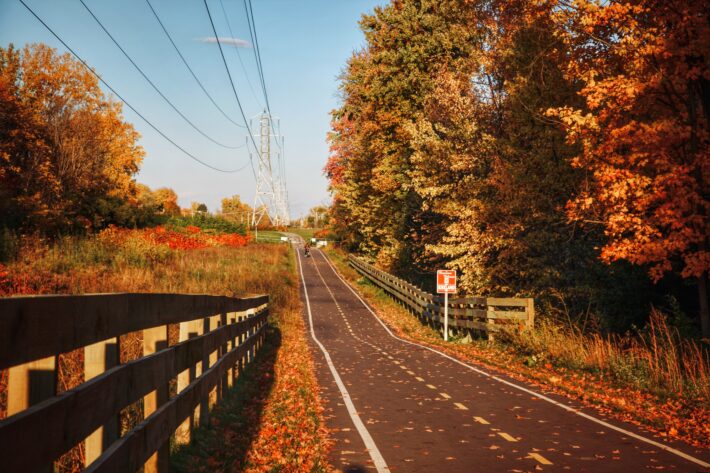
If you use hi-vis make sure it has arms – they enhance your human profile and can be seen around fairings and top boxes and from the sides.
Reflective patches, bands and stripes on riding kit, however, are often too high so fail to ‘catch’ headlights at night, especially when they’re on ‘dip’, so don’t rely on them.
ACTION: The best colour is pink for daytime riding in all environments (although Kevin concedes that this will never be a popular solution) followed by orange (which isn’t so good in autumn on rural roads), as both stand out in a wider array of backgrounds.
Another possible solution is fitting additional lights to create a ‘triangle’ that may attract the eye and help others gauge your speed and distance, although it appears there’s little evidence for this (especially in town) – so never rely on it.
Unfortunately, says Kevin, bike lights aren’t all they’re cracked up to be, for a variety of complex reasons. By the time lights become obvious to a driver, it’s often too late.
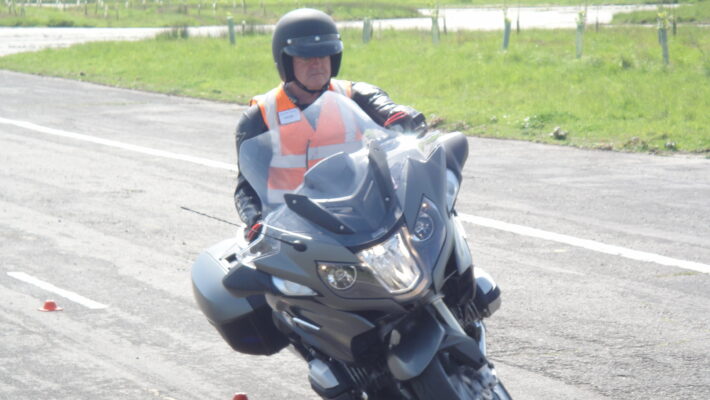
Day riding lights also need to be diffuse rather than focused, and not so bright that they are dazzling – many aftermarket DRL kits are spotlights are simply too bright. Yellow lights offer a contrast to the now standard white lights used by cars, buses and trucks so studies suggest some benefit particularly in an urban environment.
Know what goes wrong
ACTION: “At the end of the day, one of the best things you can do is lose some speed,” advises Kevin, who also enjoys track days, and who gives lectures on the Science of Being Seen (see below). “If you double your speed, you quadruple your stopping distance. If you halve your speed, your stopping distance is now a quarter of where it was.”
Kevin says that ‘surprisingly small’ reductions in speed – just a few mph – have a much bigger benefit in terms of reduced stopping and swerving distances than most riders realise, so he’s definitely not recommending that riders creep around everywhere! The idea is to think about where to roll off a bit if you sense a possible threat.
ACTION: “The other important thing to remember is that while we are mostly aware of problems from vehicles emerging from the nearside, the killer crash is often caused by the oncoming vehicle that turns right across your path. Don’t forget – always look at both sides of the road.
“At the end of the day, we can festoon ourselves in bright colours and lights, but they are only ever passive aids,” says Kevin. “If we ride into trouble, the driver has to see us and react to our presence. We’re relying on the driver to keep us safe.”
Changing position to make space, opening up lines of sight so you can be seen, creating some lateral movement to draw the driver’s attention and losing some speed are all pro-active responses to danger. Now you are taking the responsibility out of the driver’s hands. You’re taking it on yourself to stay out of trouble, instead.
Try riding as though you’ve invisible. You probably are.
BREAKOUTS
Science Of Being Seen was created in 2012 on behalf of Kent Fire & Rescue Service, as the third module of the original KFRS Biker Down course. The team won a Prince Michael of Kent International Road Safety Award that year, and SOBS went on to be delivered by Biker Down teams across the UK.
Kevin, a full-time advanced rider coach at Survival Skills Rider Training, continues to research and develop the SOBS project. It can be found here https://scienceofbeingseen.wordpress.com He has also released a paperback which mirrors the presentation, and he arranges talks for riding groups and clubs.
Kevin gave a talk on the Science of Being Seen during Road Safety GB’s online PTW event, ‘PTW Riders: improving safety and reducing collisions and casualties’, sponsored by Devitt: https://roadsafetygb.org.uk/ptwevent/programme/
David Williams is a freelance journalist who specialises in road safety, transport and travel. He’s been the London Evening Standard’s motoring correspondent for 26 years, also contributing to the Daily and Sunday Telegraph, Sunday Times and various magazines. He is a Prince Michael of Kent International Road Safety Awards judge.
Twitter Handle – @djrwilliams
2 comments on “The science of being seen – and how it could save your life”
There is one thing that I feel would have an impact, sorry no pun intended, and that would be for all aspiring drivers to gain a minimum of a CBT pass before being allowed behind the wheel. It won’t happen because politicians don’t have the courage, but ask a driving instructor about teaching bikers to drive. Bikers are so much more aware of what is going on.
Can you remember anything about the last time you drove a car and can you remember anything about the last time you rode a bike? Chances are that your recall is much clearer about the ride. Driving a car, these days, has become, for some people no more important than putting something in the fridge and even during the act driving is not uppermost in the mind. Kids playing up in the back, what’s for dinner, will I make that appointment etc etc.
People need to relearn the order of priorities in driving and everything else comes below that.
On reading the initial comment about having been a courier in London and that High vis and lights etc under certain circumstances do not work I can quite agree. I do so because London stands out as the biggest conurbation in the UK and the streets are perhaps far busier with the hustle and bustle of other towns and cities. So much so with traffic of all shapes ans sizes and weather which in at least 6 months of the year means riding in dark mornings and afternoons with a plethora of lights and shoppers and pedestrians and cyclists and vans and busses and street lighting with windows lit and also reflecting lights and lights on vehicles constantly on the move. brake lights in your face and so it no wonder that Hi vis and lighting doesn’t work as its just lost against that background of a multitude of other distractions.
Take the situation out of busy cities and towns, still ride with lights on and hi vis as to my mind and perhaps hopefully to the safety conscious mind of a few motorists you are doing your but to be seen and therefore trying to be safe. That said its no use blasting round the busy street just because you are wearing the right clothes and with lights on as your attitude to safety and our style of riding is going to be far more important than anything that you wear. You could be naked and no one would care at all. If others don’t see you and are not looking for you and that the important bit, them looking for you you might as well be naked or invisible. About invisibility It doesn’t help when we ourselves hide ourselves amongst traffic, picking the wrong places to hide away from the view of others. We need to place ourselves in the best and safest possible position to be seen, by most if not all other road road users. That sometimes is a compromise but its better being seen by say 80% of other road users rather than none at all.
One situation stands out where we frequently hide ourselves and is an extremely common collision, just less in numbers of the rear end shunt and that is a ‘smidsys’ at nearside junctions. particularly from vehicles wanting to turn out into our traffic stream or turn right in front of us and going the other way. We may be advised that whilst in traffic to place oneself to the right/ middle of your road so that you a can be seen by the drivers of the vehicle in front of you and in his offside rear view mirror. That is the worst place to ride and serves no useful purpose. Is that driver on seeing you going to alter whatever he wants to do, no he is not. Whilst you are being in this, to the right position there are junction on the nearside where drivers wanting to enter your stream are looking for such gaps in your traffic stream. You are creating that gap by being closely behind another vehicle and on seeing that gap a driver may presume there is nothing there and when that vehicle is passing his position he takes the opportunity to drive out…. on you. and turns against you. However If you were to the nearside of the road then drivers would have more chance of seeing you and thus knowing there are no gap they are moire likely to avoid a confrontation.
Having said that we must not forget the other danger as if not out to the offside to be seen by oncoming traffic one could find that a vehicle coming the other way and on not seeing you decides to that he can turn in the gap that you are making and then may collide with you anyway.
How can we be in two places at one time ? we cannot but we can help ourselves and that is by moving from our close proximity to all other vehicles in front and by the simple measure of giving space. Enough space in which we can stop in and space for others to actually have a chance of seeing us and perhaps doing the same thing. That safer following on position that we can give can reduce the risk of being not seen and give ourselves and others the space in which to brake and take avoiding action. If we do unfortunately collide then having brakes and travelling slower we mitigate the damage and or injury.